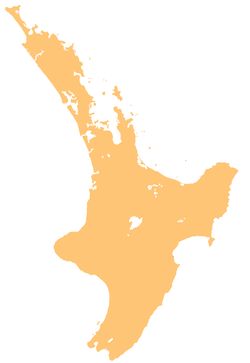
The Taupo Volcanic Zone (TVZ) is a volcanic area in the North Island of New Zealand that has been active for the past two million years and is still highly active. Mount Ruapehu marks its south-western end and the zone runs north-eastward through the Taupo and Rotorua areas and offshore into the Bay of Plenty. It is part of the larger Central Volcanic Region that extends further westward through the western Bay of Plenty to the eastern side of the Coromandel Peninsula and has been active for four million years. The Taupo Volcanic Zone is widening east–west at the rate of about 8 mm per year. It is named after Lake Taupo, the flooded caldera of the largest volcano in the zone, the Taupo Volcano.

Rotorua is a city on the southern shores of Lake Rotorua from which the city takes its name, located in the Bay of Plenty Region of New Zealand's North Island. It is the seat of the Rotorua Lakes District, a territorial authority encompassing Rotorua and several other nearby towns. The majority of the Rotorua District is in the Bay of Plenty Region, but a sizeable southern section and a small western section are in the Waikato region. Rotorua is in the heart of the North Island, 60 kilometres south of Tauranga, 80 km (50 mi) north of Taupō, 105 km (65 mi) east of Hamilton, and 230 km (140 mi) southeast of the nation's most populous city, Auckland.
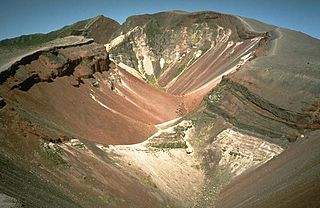
Mount Tarawera is a volcano on the North Island of New Zealand. Located 24 kilometres southeast of Rotorua, it consists of a series of rhyolitic lava domes that were fissured down the middle by an explosive basaltic eruption in 1886. This eruption was one of New Zealand's largest historical eruptions, and killed an estimated 120 people. The fissures run for about 17 kilometres northeast-southwest.

Lake Rotoroa lies within the borders of Nelson Lakes National Park in the South Island, New Zealand. The lake is fed by the D'Urville and Sabine rivers.

Lake Tikitapu or Blue Lake is the smallest of four small lakes lying between Lake Rotorua and Lake Tarawera in the Bay of Plenty region of New Zealand's North Island. The other three are Lake Rotokakahi, Lake Okareka, and Lake Okataina.

Te Wairoa is a ghost town located close to the shore of Lake Tarawera in New Zealand's North Island. It was a Māori and European settlement founded in 1848 by the Revd Seymour Mills Spencer where visitors would stay on their way to visit the Pink and White Terraces. The village was destroyed by the eruption of the volcano Mount Tarawera on June 10, 1886. 120 people died in the eruption, many of them in other villages closer to the volcano. The site of one of these villages (Kokotaia) was instrumental in the recent rediscovery of the Pink and White Terrace locations.

Lake Rotokākahi or Green Lake, is one of four small lakes lying between Lake Rotorua and Lake Tarawera in the Bay of Plenty region of New Zealand's North Island. The others are Lake Tikitapu, Lake Okareka, and Lake Okataina. All lie within the Okataina caldera, along its western edge.

Lake Okareka is one of four small lakes lying between Lake Rotorua and Lake Tarawera, in the Bay of Plenty region of New Zealand's North Island. The others are Lake Rotokakahi, Lake Tikitapu, and Lake Okataina. All lie within the Okataina caldera, along its western edge.

Lake Rotomahana is an 800-hectare (2,000-acre) lake in northern New Zealand, located 20 kilometres to the south-east of Rotorua. It is immediately south-west of the dormant volcano Mount Tarawera, and its geography was substantially altered by a major 1886 eruption of Mount Tarawera. Along with the mountain, it lies within the Okataina caldera.
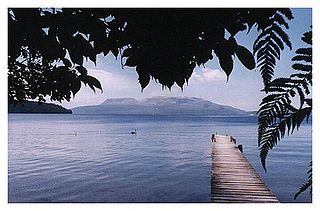
Lake Tarawera is the largest of a series of lakes which surround the volcano Mount Tarawera in the North Island of New Zealand. Like the mountain, it lies within the Okataina caldera. It is located 18 kilometres (11 mi) to the east of Rotorua, and beneath the peaks of the Tarawera massif i.e. Wahanga, Ruawahia, Tarawera and Koa. The lake's surface area is 39 square kilometres (15 sq mi).

Lake Rotorua is the second largest lake in the North Island of New Zealand by surface area, and covers 79.8 km2. With a mean depth of only 10 metres it is considerably smaller than nearby Lake Tarawera in terms of volume of water. It is located in the Bay of Plenty region. The city of Rotorua is sited on its southern shore, and the town of Ngongotahā is at the western edge of the lake.

Lake Rotoehu is the smallest in a chain of three lakes to the northeast of Lake Rotorua in New Zealand's North Island. It is located between the city of Rotorua and town of Whakatane. The southern end of the lake occupies part of the Okataina caldera. It is fed by Lake Rotoma to the east, and flows westward joining Lake Rotoiti. The lake is one of the least visited, but offers great Kayaking and fishing. It has two access points, Otautu Bay and Kennedy bay and is well located centrally to many other places e.g. the ocean, mountain biking, hiking etc. It has very good wildlife and birdlife with several rarely seen birds. In particular the endangered Kokako is located close by.

Lake Rotoma is the fourth largest lake of the 11 lakes in the Rotorua Lakes district, or the Hot Lakes district as it was known in the early decades of the 20th century. The Rotorua lakes are located in New Zealand's North Island in the Bay of Plenty Region. Lake Rotoma is the easternmost in the chain of three lakes to the northeast of Lake Rotorua The other two are Lake Rotoiti and Lake Rotoehu. Rotoma is located halfway between the city of Rotorua and town of Whakatane.

The Kaituna River is in the Bay of Plenty region of the North Island of New Zealand. It is the outflow from Lakes Rotorua and Rotoiti, and flows northwards for 45 kilometres (28 mi), emptying into the Bay of Plenty near Te Puke. It was the subject of a claim concerning the effluent flowing down the river from Lake Rotorua, which resulted in movement to a land treatment system.

Lake Waikaremoana is located in Te Urewera in the North Island of New Zealand, 60 kilometres northwest of Wairoa and 80 kilometres west-southwest of Gisborne. It covers an area of 54 km2 (21 sq mi). From the Maori Waikaremoana translates as 'sea of rippling waters'.
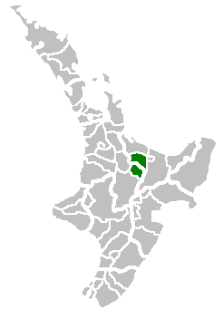
Rotorua Lakes District, known as Rotorua District from 1979 to 2014, is a territorial authority district in the North Island of New Zealand. It has one urban area of significant size, the city of Rotorua. The district is governed by Rotorua Lakes Council, which is headquartered in Rotorua and is headed by a mayor. The district falls within two regional council areas, with the majority of the area and Rotorua city in the Bay of Plenty region and the rest in the Waikato region. Steve Chadwick has been the mayor of Rotorua since the 2013 local elections.
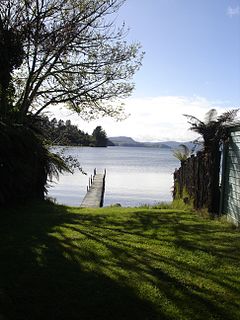
Lake Rotoiti is a lake in the Bay of Plenty region of New Zealand. It is the northwesternmost in a chain of lakes formed within the Okataina caldera. The lake is close to the northern shore of its more famous neighbour, Lake Rotorua, and is connected to it via the Ohau Channel. It drains to the Kaituna River, which flows into the Bay of Plenty near Maketu.
The region around the city of Rotorua, in New Zealand's North Island, contains several lakes. From biggest to smallest, these are Lake Rotorua, Lake Tarawera, Lake Rotoiti, Lake Rotoma, Lake Okataina, Lake Rotoehu, Lake Rotomahana, Lake Rerewhakaaitu, Lake Rotokakahi, Lake Okareka and Lake Tikitapu. There are also four smaller lakes: Lake Okaro/Ngakaro, Lake Rotokawa, Lake Rotokawau and Lake Rotongata. Most of the lakes have formed due to volcanic activity. The region is part of the Taupo Volcanic Zone, the world's most active area of explosive silicic volcanic activity in geologically recent time.

The 1886 eruption of Mount Tarawera occurred in the early hours of 10 June 1886 in the North Island near Rotorua then extended to Waimangu, New Zealand. It is the deadliest eruption in New Zealand since the arrival of Europeans. Around 120 people were killed, and many settlements were destroyed or buried.
Ōwhata is a semi-rural suburb of Rotorua in the Bay of Plenty region of New Zealand's North Island.

